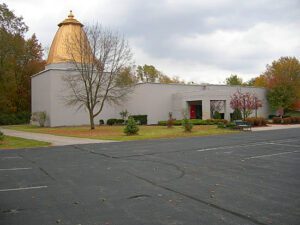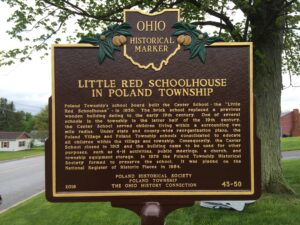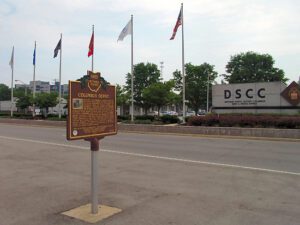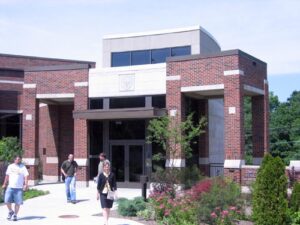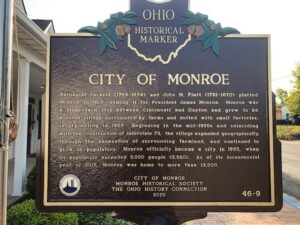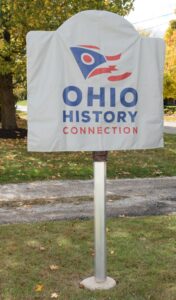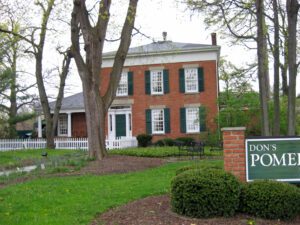, OH
The Hindu Temple of Toledo was established in 1981 for the growing Hindu and Jain communities in northwest Ohio. Religious functions were initially held in a house located on a 15-acre property purchased in 1983. The Temple, designed in a Hindu-American style, was dedicated in August 1989. In 2000, the Temple underwent an expansion of 6000 square feet to the Heritage Hall area. Deities, Ganesh, Krishna, Radha, Vishnu, Laxmi, Rama, Sita, and Mahavir, are housed in the Temple. The holy structure is a living legacy of peaceful co-existence among religions and cultures.
, OH
Poland Township’s school board built the Center School- the “Little Red Schoolhouse”- in 1858. The brick school replaced a previous wooden building dating to the early 19th century. One of several schools in the township in the latter half of the 19th century, the Center School served children living within a surrounding two mile radius. Under state and county-wide reorganization plans, the Poland Village and Poland Township schools consolidated to educate all children within the village and township. Consequently, the Center School closed in 1915 and the building came to be used for other purposes, such as 4-H activities, public meetings, a church, and township equipment storage. In 1979 the Poland Township Historical Society formed to preserve the school. It was placed on the National Register of Historic Places in 1984.
, OH
The Civil War created orphaned and impoverished children across the nation. To establish a home for area children, a group of Hamilton women met with Reverends Thane Miller and Benjamin W. Chidlaw in January 1869. By May, the women had rented a house on North C Street. Five years later, a new house was needed. Local businessmen Clark Lane and Elbridge G. Dyer pledged a combined $10,000 to purchase the property at 425 South D Street. One condition of the gift was that home’s operators had to raise an additional $2,000 to cover expenses. The newer, larger home opened in September 1875. In 1902, Robert and Eleanor Beckett McKinney donated funds to build a hospital on the property, named Ruth Hospital, to honor their deceased infant daughter. Mrs. McKinney and her mother, Martha Beckett, had long supported the home’s work. (Continued on other side)
, OH
Since 1918, this installation, currently known as the Defense Supply Center, Columbus, has served the federal government as a procurement and distribution point for military supplies and equipment. Originally named the Columbus Quartermaster Reserve Depot, this location was chosen because of its immediate access to three railroad lines. Expansion of the center continued after World War I, and in the years immediately prior to World War II, the center’s mission changed to reconditioning war material for resale. During World War II, the center became the largest military supply installation in the world, employing more than 10,000 civilians and holding over 400 Axis prisoners of war in secured barracks. The installation continues to provide a variety of parts and supplies to all branches of the Armed Forces and other Federal agencies.
, OH
Dr. Jacob Rader Marcus (1896-1995), pioneering historian of the American Jew, founded the American Jewish Archives (AJA) in Cincinnati in 1947. In the aftermath of World War II and the brutal destruction of European Jewry, Marcus anticipated the need to establish a central repository dedicated to preserving the history of North American Jewry. The AJA, which began with a few boxes of documents, has become one of the world’s largest catalogued collections of primary source material on the history of American Jewry. An international community of scholars, researchers, and students utilizes the AJA’s vast archival holdings.
, OH
Nathanial Sackett (1768-1854) and John H. Piatt (1781-1820) platted Monroe in 1817, naming it for President James Monroe. Monroe was a stagecoach stop between Cincinnati and Dayton and grew to be a rural village surrounded by farms and dotted with small factories, incorporating in 1907. Beginning in the mid-1950s and coinciding with the construction of Interstate 75, the village expanded geographically, through the annexation of surrounding farmland, and continued to grow in population. Monroe officially became a city in 1995, when its population exceeded 5,000 people (5,380). As of its bicentennial year of 2017, Monroe was home to more than 13,000.
, OH
Celebrated Cincinnati Reds pitcher and radio broadcaster, Joe Nuxhall (July 30, 1928 – November 15, 2007) grew up here in Hamilton’s North End. On these fields the endearing story of “Hamilton Joe” Nuxhall began in the summer of 1943. Scouts from the Cincinnati Reds discovered fourteen-year-old Joe while he was playing with his father’s Sunday municipal league team. Because of World War II, the rosters of major league teams were depleted as players went off to fight. Joe, displaying exceptional talent and poise for his age, met the Reds’ dire need for pitchers. He signed a contract to play for Cincinnati on February 18, 1944. On June 10, at age 15, he became the youngest player in major league history when he pitched against the World Champion St. Louis Cardinals at Cincinnati’s Crosley Field. (Continued on other side)
, OH
The Pomeroy House, built from 1847 to 1848, was the home of Alanson Pomeroy and his wife, Kezia. They continued the tradition, known as “Pomeroy Hospitality,” that began when Alanson’s parents established a tavern in Strongsville. Prominent in the community, Alanson served as township trustee and Justice of the Peace in Strongsville Township, and was a leader in the Congregational Church. Oral tradition holds that the Pomeroy House served as a stop on the Underground Railroad. Runaway slaves were brought from Oberlin, often concealed under bales of hay in wagons, and hidden in the cellar of the house until they could be safely taken to Rocky River. From there, the fugitives boarded ships headed to Canada. The Pomeroy House, listed on the National Register of Historic Places, was restored in 1979 and opened as Don’s Pomeroy House restaurant in 1980.


